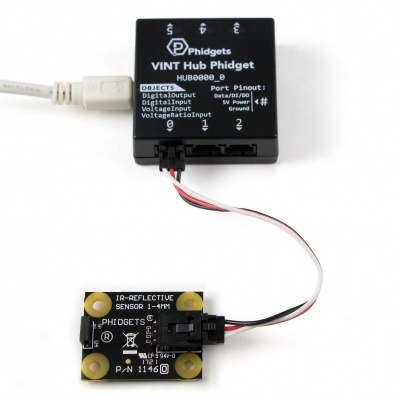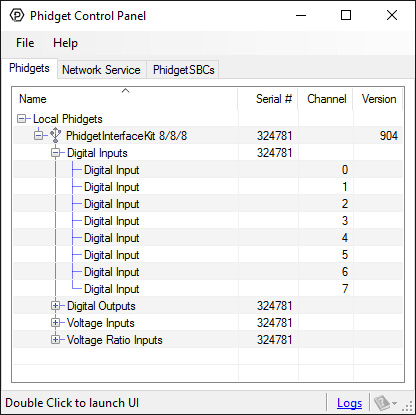1146 User Guide: Difference between revisions
No edit summary |
|||
| Line 23: | Line 23: | ||
This sensor can detect the distance of an object from 1mm to 4mm away. Objects with smooth, opaque surfaces are typically easier to detect. | This sensor can detect the distance of an object from 1mm to 4mm away. Objects with smooth, opaque surfaces are typically easier to detect. | ||
The sensor value changes from 900 to 30 as the object is moving closer to the sensor from a distance of 4mm. When the object is more than 4mm away, you may notice some change in sensor value as the object enters or leaves the sensor's field of view, but this value does not represent the actual distance to the object. | The sensor value changes from 900 to 30 as the object is moving closer to the sensor from a distance of 4mm. When the object is more than 4mm away, you may notice some change in sensor value as the object enters or leaves the sensor's field of view, but this value does not represent the actual distance to the object. The exact equation for the sensor is as follows: | ||
'''Distance (mm) = 1.3927*e^(0.001967*SensorValue)''' | |||
The IR sensor works just as well in both dim and well lit areas. | The IR sensor works just as well in both dim and well lit areas. | ||
Revision as of 07:27, 28 October 2016
Required Hardware
- A 1146 IR Reflective Sensor
- An InterfaceKit or Hub to read the sensor
- A Phidget cable
- A USB cable
- A computer
Connecting the Pieces

- Connect the reflective sensor to the InterfaceKit or Hub with the Phidget cable.
- Connect the InterfaceKit or Hub to your computer with the USB cable.
Testing Using Windows
Phidget Control Panel
In order to demonstrate the functionality of the 1018, the Phidget Control Panel running on a Windows machine will be used.
The Phidget Control Panel is available for use on both macOS and Windows machines.
Windows
To open the Phidget Control Panel on Windows, find the ![]() icon in the taskbar. If it is not there, open up the start menu and search for Phidget Control Panel
icon in the taskbar. If it is not there, open up the start menu and search for Phidget Control Panel
macOS
To open the Phidget Control Panel on macOS, open Finder and navigate to the Phidget Control Panel in the Applications list. Double click on the ![]() icon to bring up the Phidget Control Panel.
icon to bring up the Phidget Control Panel.
For more information, take a look at the getting started guide for your operating system:
Linux users can follow the getting started with Linux guide and continue reading here for more information about the 1018.
First Look
After plugging the 1018 into your computer and opening the Phidget Control Panel, you will see something like this:

The Phidget Control Panel will list all connected Phidgets and associated objects, as well as the following information:
- Serial number: allows you to differentiate between similar Phidgets.
- Channel: allows you to differentiate between similar objects on a Phidget.
- Version number: corresponds to the firmware version your Phidget is running. If your Phidget is listed in red, your firmware is out of date. Update the firmware by double-clicking the entry.
The Phidget Control Panel can also be used to test your device. Double-clicking on an object will open an example.
Voltage Input
Double-click on a Voltage Input object in order to run the example: [[Image:{{{1}}}_VoltageInputSensor_Example.jpg|center|link=]]
General information about the selected object will be displayed at the top of the window. You can also experiment with the following functionality:
- Modify the change trigger and/or data interval value by dragging the sliders. For more information on these settings, see the data interval/change trigger page.
- If you have an analog sensor connected that you bought from us, you can select it from the Sensor Type drop-down menu. The example will then convert the voltage into a more meaningful value based on your sensor, with units included, and display it beside the Sensor Value label. Converting voltage to a Sensor Value is not specific to this example, it is handled by the Phidget libraries, with functions you have access to when you begin developing!
For more information about Voltage Inputs, check out the Voltage Input Primer.
Testing Using Mac OS X
- Go to the Quick Downloads section on the Mac OS X page.
- Download and run the Phidget OS X Installer
- Click on System Preferences >> Phidgets (under Other) to activate the Preference Pane
- Make sure your device is properly attached
- Double click on your device's objects in the listing to open them. The Preference Pane and examples will function very similarly to the ones described above in the Windows section.
Testing Using Linux
For a general step-by-step guide on getting Phidgets running on Linux, see the Linux page.
Using a Remote OS
We recommend testing your Phidget on a desktop OS before moving on to remote OS. Once you've tested your Phidget, you can go to the PhidgetSBC, or iOS pages to learn how to proceed.
Technical Details
This sensor can detect the distance of an object from 1mm to 4mm away. Objects with smooth, opaque surfaces are typically easier to detect.
The sensor value changes from 900 to 30 as the object is moving closer to the sensor from a distance of 4mm. When the object is more than 4mm away, you may notice some change in sensor value as the object enters or leaves the sensor's field of view, but this value does not represent the actual distance to the object. The exact equation for the sensor is as follows:
Distance (mm) = 1.3927*e^(0.001967*SensorValue)
The IR sensor works just as well in both dim and well lit areas.
Phidget Cable

The Phidget Cable is a 3-pin, 0.100 inch pitch locking connector. Pictured here is a plug with the connections labelled. The connectors are commonly available - refer to the Analog Input Primer for manufacturer part numbers.
What to do Next
- Programming Languages - Find your preferred programming language here and learn how to write your own code with Phidgets!
- Phidget Programming Basics - Once you have set up Phidgets to work with your programming environment, we recommend you read our page on to learn the fundamentals of programming with Phidgets.
